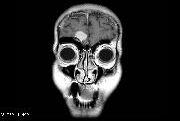Learning Objectives
- Ramsay Hunt syndrome is a cranial neuropathy caused by varicella zoster
- It affects cranial nerves VII and VIII
- Treatment may require antiviral medicine, corticosteroids, pain treatment, and treatment for balance symptoms
History
A 57 year old man develops a painful sore in the right ear. After a few days, the sores become a crust. He begins to develop a burning pain in his right ear, and then a day later, reduced hearing, dizziness, nausea, and facial weakness on the right side. He is brought to your clinic in a wheelchair.
When he is not feeling ill, he takes ibuprofen occasionally. He is allergic to cephalexin.
He has a past medical history of a third degree burn on the left forearm and subsequent skin graft and infection. He has moderate osteoarthritis affecting his knees. His medical history is otherwise unremarkable.
He has a family history of Diabetes mellitus in his mother and leukemia in his father (who died at age 48).
He does not drink or smoke.
Review of systems: he denies fever, chest pain, difficulty breathing, dysuria, diarrhea or constipation. His only rash affects the right ear as described. He has knee pain from time to time. It is no different than usual at this time. His sleeping is normal. His vision is normal. He denies bruising or bleeding.
Examination
His temperature is 99.3 F, his blood pressure is 117/68, and his pulse is 72. He is an alert but pale-appearing man sitting in a wheelchair. His carotid and cardiac auscultation are normal. Pupils are reactive to direct and indirect light. The right ear has a crusting, vesicular rash affecting the external auditory meatus. Examination of the right TM is limited by pain. His cognitive function is intact. Movement of the right upper and lower facial expression is moderately impaired. Eye motions are normal. No nystagmus is present. Hearing is reduced to 256 Hz in the right ear and normal in the left. Facial sensation is normal. Tongue and palate movements are normal. Sternocleidomastoid strength was normal. He has normal strength in the proximal and distal muscles of the arms and legs. The deep tendon reflexes are normal. The toes move down to plantar stimulation. He has normal sensation to vibration and pin in the arms, trunk and the legs. Romberg is positive. Finger nose finger movements are normal. He cannot walk without assistance.
Localization and Neuroanatomy
This is a 57 year old man with a rash affecting the right ear, right upper and lower facial weakness, reduced hearing on the right side, nausea and difficulty walking. The cranial nerve deficits suggest a peripheral VIIth nerve lesion and a peripheral VIIIth nerve lesion, possibly one affecting both vestibular and cochlear functions. Considering this history a condition called Ramsay Hunt syndrome might be suspected. In this condition, viral infection is reactivated in a geniculate ganglion. The nearby VIIIth nerve may also be affected.
Diagnosis
The differential diagnosis of a peripheral VII and VIII nerve lesion is trauma, compressing tumor (such as Schwannoma), viral infection, and stroke. Disease of cranial nerve VII can also be caused by Bell’s palsy or Lyme disease. Ramsay Hunt syndrome is a condition to consider whenever both VII and VIII are affected.
The clinical signs of Ramsay Hunt syndrome may vary. Patients may have a rash, facial weakness, vertigo, disequilibrium, reduced hearing, tinnitus, nystagmus, or hyperacusis. The timing of presentation also may vary from case to case. The diagnosis of this condition may be made on clinical grounds, but the variable presentation and possibility of alternate conditions may make this determination difficult.
Testing for Ramsay Hunt can be done by scraping fluid from the base of a blister. This may be sent for direct fluorescence antibody and/or culture. Patients without a vesicular lesion may have viral DNA in their CSF. MRI dedicated to CN VII and VIII may show nerve enhancement, but MRI is primarily used to show that other causes of the symptoms are not present.
Treatment
Treatment for Ramsay Hunt syndrome is somewhat controversial because there have been few randomized controlled clinical trials. It is accepted that corticosteroids and antiviral medication prevents debility. The optimal doses and duration of therapy are uncertain. Oral prednisone, 60 mg daily for 1-2 weeks, with a taper, is often recommended. An antiviral medicine such as acyclovir or valacyclovir is often provided concurrently. Treatment within the first 72 hours of symptoms is felt to be most effective.
A patient with Ramsay Hunt syndrome may have symptoms for weeks or months. Pain symptoms may be treated with gabapentin. This is often used for neuralgia due to the zoster virus. Another option might be amitriptyline. Anti-nausea or anti-dysequilibrium medicine such as diazepam may also be helpful. Patients with Ramsay Hunt syndrome may benefit from PT and OT services also.
Review Questions
- Ramsay hunt syndrome affects which two cranial nerves?
a. III and IV
b. V and VI
c. VI and VII
d. VII and VIII
e. IX and X - The infection that is associated with Ramsay Hunt syndrome is
a. Varicella zoster
b. Herpes simplex
c. HIV
d. Lyme disease
e. Neisseria meningitidis - Although no case-controlled clinical trial supports this, providers recommend that Ramsay Hunt syndrome be treated with
a. antiviral medication
b. corticosteroids
c. broad spectrum intravenous antibiotics
d. symptomatic pain relief
e. both A and B
